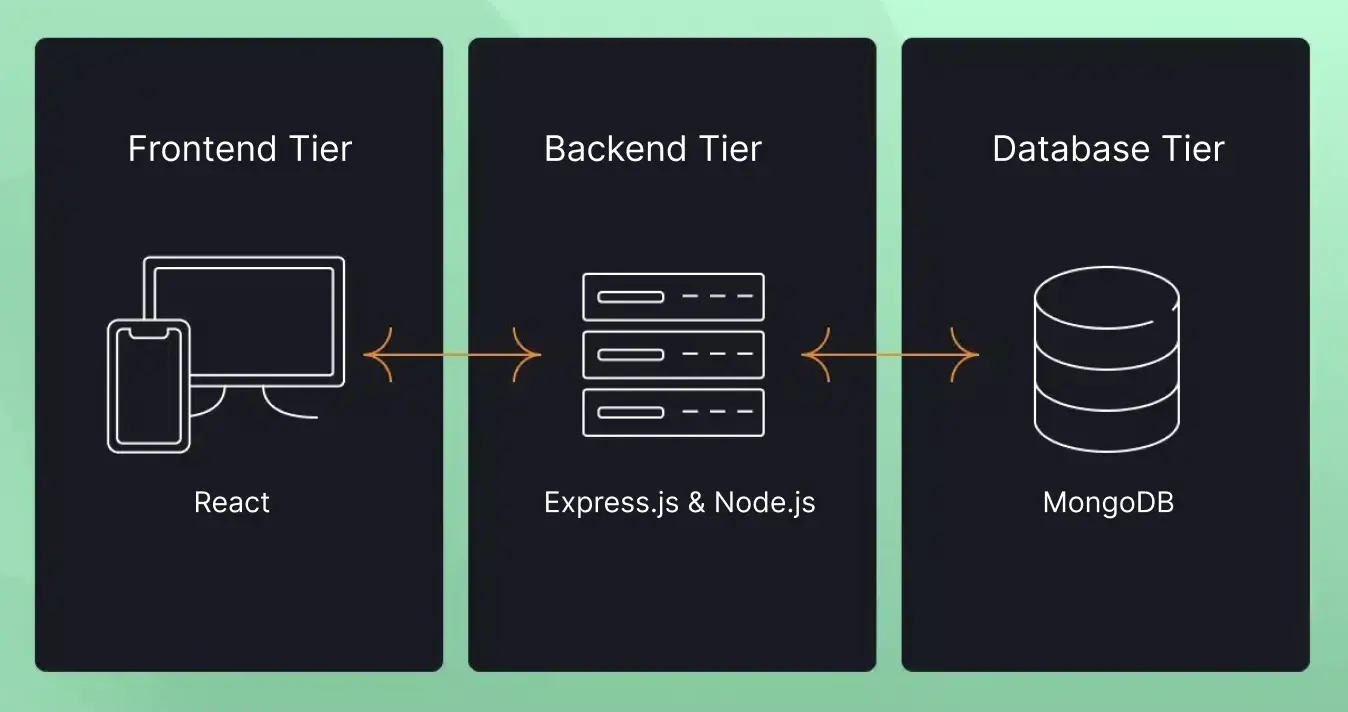When developing scalable web applications with JavaScript, developers have a wide range of technologies to choose from. With so many options available, selecting the right one can be challenging.
However, with the MERN stack, developers can easily build full-stack web applications that are maintainable, scalable, and secure.
What is MERN Stack?
The MERN stack is a full-stack framework comprising four major JavaScript-based components: MongoDB, Express.js, React.js, and Node.js.
These components are widely used for building modern web applications, especially single-page applications (SPAs) and dynamic websites. Since it runs entirely on JavaScript, developers can work seamlessly across the front end and back end, streamlining the development process.
Each MERN stack component has unique features that make it well-suited for various applications. It consists of four main components:
MongoDB: a document-oriented NoSQL database for high-volume data storage, using flexible JSON-like documents with dynamic schemas.
Express.js: a lightweight Node.js framework for building web applications and APIs, handling HTTP requests, middleware, and routing.
React.js: a JavaScript library for building fast, interactive UIs, especially for single-page applications, using a component-based architecture.
Node.js: an open-source JavaScript runtime for executing code outside the browser, commonly used for scalable web applications, APIs, and backend services.
How the MERN Stack Works
The MERN stack consists of three main tiers: the database, backend, and frontend. Each layer plays a crucial role in ensuring seamless application functionality.
Database Tier (MongoDB)
The database tier manages and stores the application’s data. MERN utilizes MongoDB, a NoSQL database that stores data in a document-oriented format, offering flexibility and scalability.
Unlike relational databases with fixed schemas and structured tables, MongoDB organizes data in BSON (Binary JSON) documents, allowing dynamic schema modifications without major structural changes.
MongoDB's flexibility makes it ideal for modern applications handling unstructured or semi-structured data. It supports replication, sharding, and indexing, ensuring high availability and performance as applications scale.
This makes it particularly useful for managing large volumes of user-generated content, real-time data, or complex relationships without sacrificing speed and efficiency.
Backend Tier (Express.js and Node.js)
The backend tier comprises Express.js and Node.js, which together form the core of the server-side logic.
Express.js is a lightweight and fast web application framework for Node.js that simplifies building APIs and handling HTTP requests. It provides features such as middleware support, routing, and request handling, making backend development more efficient. Developers can easily create RESTful APIs to manage data flow between the frontend and the database.
Node.js is a runtime environment that allows JavaScript to run outside the browser. Built on Chrome’s V8 engine, it enables fast execution of JavaScript code. Its event-driven, non-blocking I/O model makes it ideal for handling asynchronous operations, such as processing multiple user requests simultaneously without slowing down performance
Frontend Tier (React.js)
The frontend tier is responsible for rendering the user interface and managing client-side interactions. MERN applications use React.js, a JavaScript library developed by Meta (formerly Facebook), enabling the development of highly interactive and dynamic web applications.
React follows a component-based architecture, allowing developers to break down the user interface into reusable, modular components. This approach enhances code reusability and maintainability, reducing the time and effort required for frontend development.
One of React's key advantages is its use of the Virtual DOM (Document Object Model), which optimizes rendering performance by updating only the necessary components instead of reloading the entire page. This ensures smooth and responsive user experiences, especially in single-page applications (SPAs) that require real-time updates and dynamic content rendering.
The diagram below illustrates the interaction between these tiers within the MERN stack architecture.

Why is the MERN Stack So Popular?
The MERN stack has become one of the most popular choices for JavaScript developers when building modern, efficient, and dynamic web applications. It is particularly well-suited for developers looking to leverage the power of JavaScript across both the frontend and backend, thanks to its full-stack ecosystem.
The stack is composed of four key technologies: MongoDB, Express.js, React.js, and Node.js, which together create a powerful and streamlined development environment. This unification of technologies allows for a smoother development experience, as developers can work with a single language (JavaScript) throughout the entire application lifecycle, reducing the need to juggle multiple languages and frameworks.
Let’s explore some of the advantages and features that contribute to the MERN stack’s popularity in web development:
Full-Stack JavaScript
The MERN stack uses JavaScript for both the frontend and backend, streamlining application development by removing the need to learn multiple languages for a single project. With this stack, full-stack developers can work across the entire application using JavaScript, eliminating the necessity of mastering a different backend language. This JavaScript-based approach simplifies development and contributes to the MERN stack’s popularity in web development.
NoSQL Database
MongoDB, a NoSQL database integral to the MERN stack, offers flexibility and scalability. Unlike relational databases, it stores data in BSON (Binary JSON) format, enabling dynamic schema changes and efficient handling of unstructured or semi-structured data. Features such as sharding and replica sets further support horizontal scalability and high availability, making MongoDB suitable for projects of all sizes, from startups to large enterprises.
High Performance and Scalability
The MERN stack provides exceptional performance through lightweight components and an efficient runtime. The Node.js backend component, built on the V8 JavaScript engine, offers a non-blocking, event-driven architecture that handles concurrent requests with minimal overhead, ensuring efficiency even under heavy traffic. This makes it ideal for building real-time applications such as social media platforms, messaging apps, and e-commerce sites.
MongoDB achieves horizontal scaling through sharding, which involves distributing data across multiple servers to manage large datasets and high throughput operations effectively.
Modular and Maintainable Architecture
The MERN stack's modular architecture enhances maintainability and scalability by clearly defining the roles of each component—MongoDB, Express, React, and Node.js. This structure allows developers to work on individual parts without impacting the entire system, facilitating easier updates, refactoring, and feature extensions.
React's component-based design further promotes reusability by enabling the breakdown of the user interface into modular components. This approach accelerates development and simplifies the management and scaling of applications over time.
Strong Community Support
The MERN stack's popularity is largely due to its active community and the widespread use of JavaScript. This community offers a wealth of resources, tutorials, libraries, and tools that accelerate development. Whether you're a beginner or an experienced developer, extensive documentation and support are available through forums, online courses, and open-source projects.
The growth of React has further strengthened the stack's ecosystem, contributing to its adoption for developing user interfaces in modern web applications. With active community contributions and regular updates to the stack's core technologies, developers can be confident in using a modern, well-supported technology stack.
Key Differences Between MERN and Other Stacks
Language Consistency: MERN uses JavaScript across the entire stack, whereas other stacks like LAMP, Django, or Ruby on Rails require developers to work with multiple languages (e.g., PHP, Python, Ruby).
Database: MERN uses MongoDB (NoSQL) for flexible, schema-less data storage, while LAMP, Django, and Rails use relational databases like MySQL and PostgreSQL, which are optimized for structured data and complex relationships.
Frontend Framework: MERN uses React, a dynamic and flexible frontend library, while MEAN uses Angular, and Django, Rails, and LAMP rely on traditional server-side templating systems.
Performance: The MERN stack is highly scalable and efficient for real-time applications, thanks to Node.js's non-blocking architecture. In contrast, LAMP and Django excel at data-driven websites but may not perform as well in real-time scenarios.
Development Speed: MERN and MEAN enable rapid development with JavaScript’s asynchronous capabilities and large ecosystems. While LAMP and Rails also support fast development, Rails follows a convention-over-configuration approach, whereas LAMP requires more manual setup.
Conclusion
The MERN stack provides a cohesive framework for developing modern web applications. It utilizes JavaScript across all layers — MongoDB for flexible data storage, Express.js for robust server-side networking, React.js for dynamic user interfaces, and Node.js for scalable backend services — to streamline development and enhance performance.
This unified approach makes it an excellent choice for developers seeking efficiency and scalability in building high-performance web applications.
Frequently Asked Questions
How does Verpex ensure the latest technology stack is used for Vue.js hosting?
Verpex continuously updates its hosting infrastructure to ensure compatibility with the latest Vue.js versions and dependencies. We implement regular server updates and testing to maintain a modern, secure, and efficient hosting environment.
Does MongoDB support ACID transactions?
MongoDB has improved its support for ACID transactions in recent versions, but it is important to note that its transactional capabilities are not as mature as those of PostgreSQL. For applications heavily reliant on complex transactions, PostgreSQL may be a more suitable choice.
What are some big companies that use MongoDB and PostgreSQL?
MongoDB is used by companies like Adobe, eBay, and IBM. PostgreSQL is used by organizations like Apple, Cisco, and Fujitsu. Both databases have a significant presence in the industry.
How does Express.js middleware contribute to the maintainability of code?
Express.js middleware enhances code maintainability by promoting a modular and organized structure. Developers can compartmentalize specific functionalities into middleware functions, making managing and updating individual components easier.

Joel Olawanle is a Software Engineer and Technical Writer with over three years of experience helping companies communicate their products effectively through technical articles.
View all posts by Joel Olawanle




















